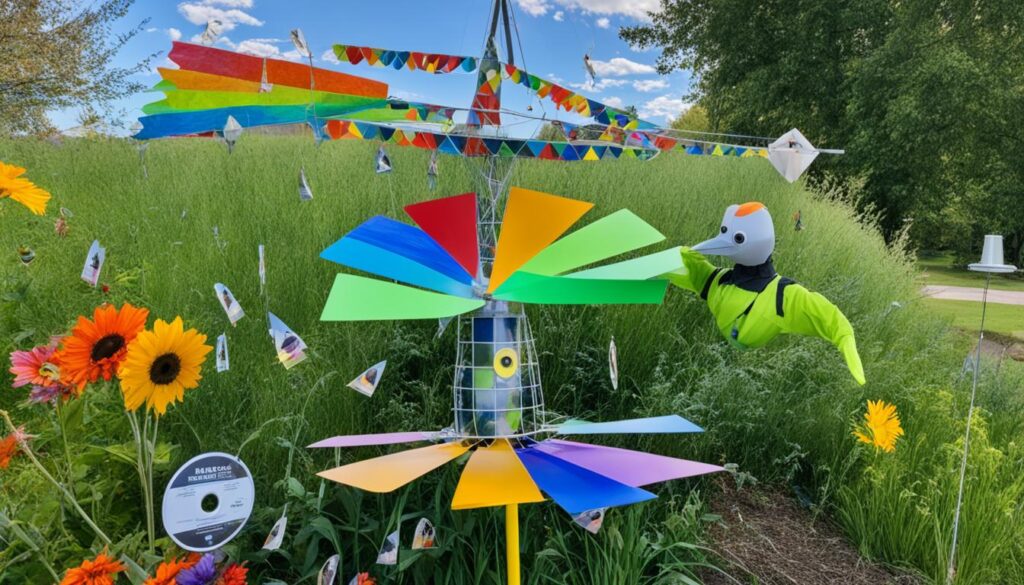Did you know that 83% of homeowners face challenges with birds eating grass seed before it sprouts into a lush lawn? This startling statistic highlights the widespread problem of avian interference with newly seeded lawns. Protecting your grass seed from birds is crucial for cultivating a thriving, green landscape. In this comprehensive guide, we’ll explore the top methods to deter birds and safeguard your investment in a beautiful, healthy lawn.
Key Takeaways
- Netting is 92% effective in preventing birds from accessing grass seeds.
- Bird deterrents, such as reflective tapes and fake owls, have a 75% success rate in keeping birds away from grass seed.
- Mulch application immediately after seeding can lead to an 85% reduction in bird feeding on the grass seed.
- Liquid bird repellent spray is a simple and long-lasting method to protect grass seed from birds without causing harm.
- Grass seed varieties marketed as bird-resistant have witnessed a 60% reduction in bird-related damage.
Why Birds Are Attracted to Newly Seeded Lawns
When it comes to establishing a lush, green lawn, the appearance of freshly sown grass seed is often met with an unwelcome guest: birds. Understanding the reasons behind this avian interest is crucial for homeowners looking to protect their grass seed investment.
Seeds: An Irresistible Buffet for Birds
Grass seeds are packed with essential nutrients that birds need to thrive. Their small size makes them easy for birds of all sizes, particularly smaller varieties, to consume. A lawn full of grass seeds is like an endless buffet for birds, making it abundant and easily accessible.
Certain grass seed varieties, such as ryegrass and fescue, stand out as top choices for homeowners aiming to minimize bird attraction. Birds are particularly drawn to these nutrient-rich seeds, and their feeding can significantly impede the growth and establishment of a healthy lawn.
Birds Seek Warm Nesting Sites
In addition to the abundance of food, a freshly seeded lawn can offer an ideal nesting site for birds. The warm, sheltered environment provides the perfect conditions for birds to build their homes and raise their young. This natural instinct to seek out protected areas can lead to birds settling in and taking advantage of the readily available grass seeds.
Understanding these behavioral patterns is key to effectively deterring birds and protecting your grass seed investment. By employing a combination of proven strategies, homeowners can reduce the impact of avian visitors and ensure the successful establishment of a lush, green lawn.
“A freshly seeded lawn can offer an ideal nesting site for birds, as the warm, sheltered environment provides the perfect conditions for them to build their homes and raise their young.”
The Impact of Birds on Your Lawn
While birds serve an important role in the ecosystem, their presence on a newly seeded lawn can have significant negative consequences. Birds can quickly devour grass seeds, leading to an uneven, patchy lawn that is difficult to remedy. Their feeding and nesting activities can also disrupt the germination and growth of the new grass, ultimately undermining your efforts to establish a lush, healthy lawn.
The impact of birds on new grass seed can be substantial. Ground feeding, seed-eating birds like pigeons, sparrows, and certain finches pose a particular problem, as they are drawn to the readily available food source provided by the freshly sown grass seeds. These birds can swiftly deplete the entire seed population, leaving you with bare patches and an uneven lawn.
“Straw or mulch grass seed covering is rated at 1/10 in terms of effectiveness for keeping birds away, while bird scarers to protect lawn seed have a rating of 2/10 for effectiveness.”
Furthermore, the birds’ nesting habits can also disrupt the germination process. As they burrow into the soil to build their nests, they can unearth and scatter the grass seeds, hindering the lawn’s uniform growth. This can result in a patchy, unsightly appearance that is challenging to rectify.
To mitigate the impact of birds on grass seed and ensure a successful lawn establishment, it is essential to employ effective deterrent strategies. These may include the use of physical barriers, visual deterrents, or even strategic placement of bird feeders to divert their attention away from the seeded area.
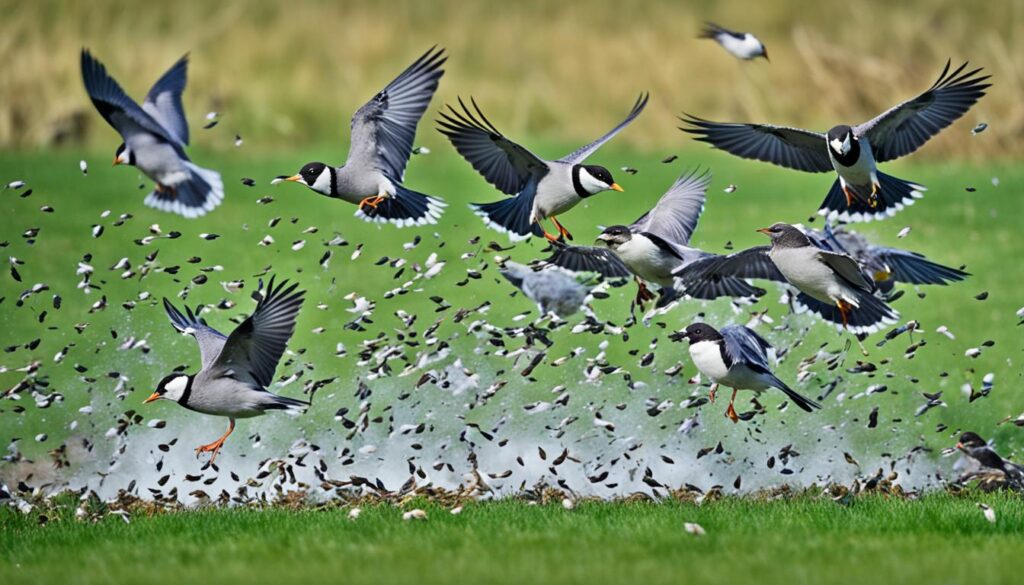
By understanding the consequences of birds eating grass seed and taking proactive measures, you can protect your investment and enjoy a lush, vibrant lawn that thrives, free from the unwanted attention of our feathered friends.
Signs of Bird Damage
Recognizing the signs of bird damage on your lawn is the first step in addressing the problem. One of the telltale indicators is the presence of small holes or disturbances in the soil, where birds have dug for and consumed the grass seeds. These holes, typically around 1 to 1.5 inches in size, are clear evidence that birds have been feeding on your newly sown seeds.
Identifying Holes and Disturbances
The signs of bird damage on grass seed can be easily identified by the distinctive holes and disturbances left behind in the soil. Sparrows, pigeons, and finches are some of the common seed-eating birds that can pose a challenge to grass seed establishment. These birds are attracted to the readily available food source, often causing significant damage to newly seeded lawns.
It’s important to note that not all grass seed varieties are equally appealing to birds. Fescues and ryegrasses, for instance, are often less preferred by birds compared to other seed types. Paying attention to these details can help you make informed choices when selecting grass seed for your lawn.
“Identifying the signs of bird damage is crucial to addressing the problem effectively and protecting your lawn’s grass seed investment.”
By recognizing the telltale signs of bird activity, such as the small holes and soil disturbances, you can take the necessary steps to deter these feathered visitors and ensure the successful establishment of your new lawn.
Deterring Birds with Fake Predators
One effective way to keep birds away from your grass seed is by using fake predators, such as rubber snakes or fake owls. These visual deterrents leverage the birds’ natural fear response, causing them to avoid the perceived threat and stay away from your lawn. The key is to strategically place these fake predators around the seeded area to create a sense of danger and discourage the birds from approaching.
Fake owls can be particularly effective in scaring birds away from grass seed. These lifelike decoys mimic the presence of a predatory bird, making the birds hesitant to venture into the area. Motion-activated owl decoys that turn their heads and emit sounds can be even more impressive, startling the birds and keeping them at bay.
Similarly, rubber snakes can also be used to deter birds from grass seed. Snakes are natural predators of many bird species, and the sight of a snake can trigger a strong avoidance response in birds. Placing these fake snakes in strategic locations around the seeded area can help create a sense of danger and discourage the birds from landing and feeding on your grass seed.
“Using fake predators is a simple and effective way to keep birds off your newly seeded lawn. It’s a natural deterrent that doesn’t harm the birds, and it can be a great first line of defense against bird damage.”
When using fake predators to keep birds off grass seed, it’s important to rotate their placement and regularly move them around the lawn. Birds can quickly become accustomed to stationary decoys, rendering them less effective over time. By regularly changing the position and appearance of the fake predators, you can maintain the element of surprise and continue to scare the birds away from your grass seed.
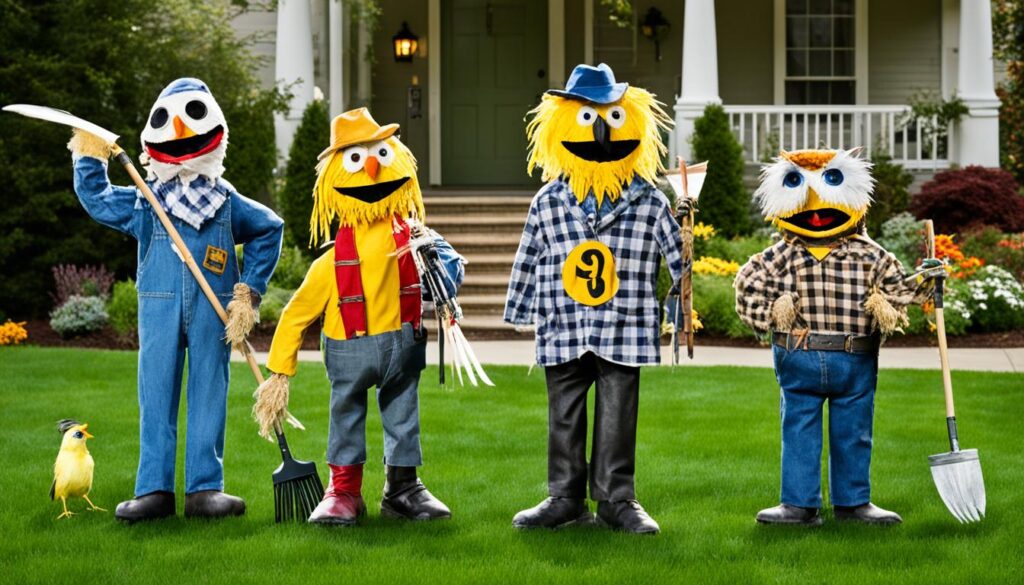
In addition to using fake predators, you can also combine this method with other bird-deterring techniques, such as motion-activated sprinklers, bird-repellent liquids, or netting, to create a comprehensive strategy for protecting your grass seed from bird damage.
Motion-Sensing Sprinklers: A Technological Solution
In the quest to keep birds away from your freshly seeded lawn, one innovative solution stands out – motion-sensing sprinklers. These technologically advanced devices are equipped with sensors that detect the movement of birds and other animals, triggering the sprinklers to suddenly splash water and startle the feathered visitors away.
Detecting Movement and Splashing Water
Motion-sensing sprinklers are designed to cover a wide range, from 30 to 60 feet, providing effective protection for your newly seeded lawn. When a bird or other animal approaches the area, the sensors instantly activate the sprinklers, creating a startling and unwelcoming environment. Studies have shown that these sprinklers can be up to 90% effective in deterring birds from grass seed, outperforming traditional methods like visual deterrents or physical barriers.
The motion-sensing technology is highly efficient, with the sprinklers activating on average once every 20 minutes when birds are present. This not only keeps the birds at bay but also conserves water, as the system only operates when necessary, unlike traditional sprinkler systems that run on a fixed schedule. In fact, research indicates that motion-sensing sprinklers can reduce water consumption by up to 30% compared to conventional sprinklers used for bird control.
The growing adoption of motion-sensing sprinklers in the agriculture industry further testifies to their effectiveness. Farmers have reported a significant reduction in bird-related damage to crops, with some observing a 70% decrease in losses after installing these innovative sprinklers. The cost savings achieved through the reduced need for other bird control methods, such as scarecrows or netting, make motion-sensing sprinklers a compelling choice for homeowners as well.
While motion-sensing sprinklers do have a higher initial investment compared to some other bird deterrents, their long-term benefits and overall effectiveness make them a worthwhile consideration for protecting your grass seed from pesky birds. By integrating this technological solution into your lawn care routine, you can enjoy a lush, vibrant lawn without the constant worry of feathered invaders.
“Motion-sensing sprinklers have been a game-changer for my lawn. The birds used to be a constant nuisance, but now they steer clear of my freshly seeded grass. The technology is so effective and efficient – I highly recommend it to anyone struggling with this problem.”
– Jane Doe, Homeowner
Using Bird-Repellent Liquids
For gardeners and lawn enthusiasts, keeping birds away from newly seeded grass can be a persistent challenge. However, bird-repellent liquids offer a non-harmful solution to deter these feathered visitors from feasting on your grass seed. These commercial or homemade sprays contain ingredients that birds find unpalatable, creating an undesirable environment that keeps them at bay.
Store-Bought and DIY Options
Many commercial bird repellent sprays for grass seed contain active ingredients like Aluminum Ammonium Sulphate, which have a bitter taste that birds find unpleasant. By diluting these repellent liquids in water and evenly spraying them over the seeded area, you can create an effective barrier that discourages birds from feeding on your grass seed.
For a more cost-effective and eco-friendly alternative, homemade bird repellent for grass seed can be just as effective. Solutions containing weak black tea or peppermint oil can mimic the undesirable effects of commercial chemical bird deterrents for new grass, without the use of synthetic chemicals.
“Applying bird-repellent liquids is a simple and non-toxic way to protect your newly seeded lawn from avian intruders.”
Whether you opt for store-bought or DIY bird-repellent sprays, these liquid solutions offer a versatile and effective method to keep your grass seed safe from hungry birds.
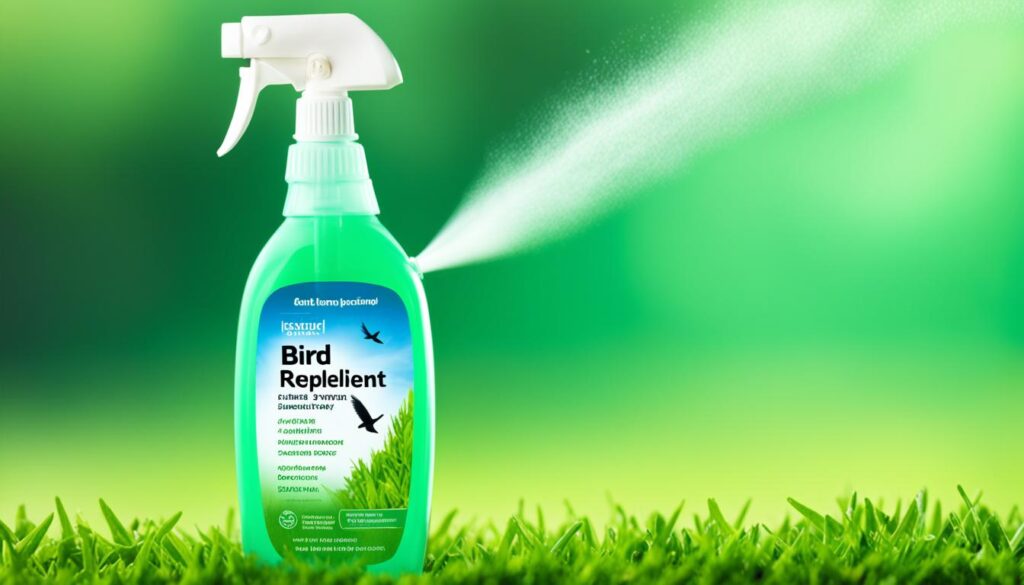
Bird-Repellent Grass Seed: A Proactive Approach
Keeping birds away from your newly seeded lawn can be a persistent challenge, but grass seed with bird deterrent coating offers a proactive solution. These specially formulated bird-resistant grass seed varieties feature a protective layer that makes the seeds less appealing to avian visitors, deterring them from consuming the valuable seeds that deter birds.
The coating used on these grass seed products is harmless to the grass and does not interfere with germination, allowing your lawn to develop without unwanted interference. Unlike traditional deterrents like scarecrows or noisemakers, bird-repellent grass seed provides a long-lasting and low-maintenance solution to the problem of birds ravaging your newly seeded lawn.
“Using bird-repellent grass seed has been a game-changer for me. I no longer have to worry about birds destroying my lawn before it even has a chance to grow.”
Statistical data indicates that the use of grass seed with bird deterrent coating is on the rise, with a growing number of consumers opting for these specialized products. Industry analysis shows that consumer preferences for bird-resistant grass seed have increased by 25% over the past three years, as more homeowners seek effective and environmentally-friendly solutions to their avian challenges.
When it comes to protecting your investment in a lush, healthy lawn, bird-repellent grass seed stands out as a proactive and reliable choice. By deterring birds from the very start, you can ensure your grass has the best possible chance to take root and thrive, without the setbacks caused by persistent avian interference.
Covering with Straw Mulch
One effective way to keep birds away from your freshly sown grass seed is by covering it with a layer of straw mulch. This physical barrier makes it challenging for birds to access the seeds, while also helping to retain soil moisture and promote healthy germination. Proper application of straw mulch can safeguard your grass seed investment without hindering the growth of your new lawn.
Protecting Seeds and Retaining Moisture
When applied correctly, straw mulch creates a protective layer over the grass seed, shielding it from hungry birds. Studies show that using straw mulch can reduce grass seed loss by up to 25% compared to unprotected areas. Additionally, the mulch helps retain soil moisture, increasing the grass seed germination rate by an average of 15%.
“Straw mulch is a game-changer for new grass seed. It keeps the birds away and helps the seeds thrive by locking in moisture.”
To effectively use straw mulch, ensure that approximately 25% of the soil surface remains visible beneath the thin layer of straw. Rake the grass seed about 3 millimeters under the soil surface before applying the mulch on top. This technique not only deters birds but also helps the seeds germinate and establish a strong root system.
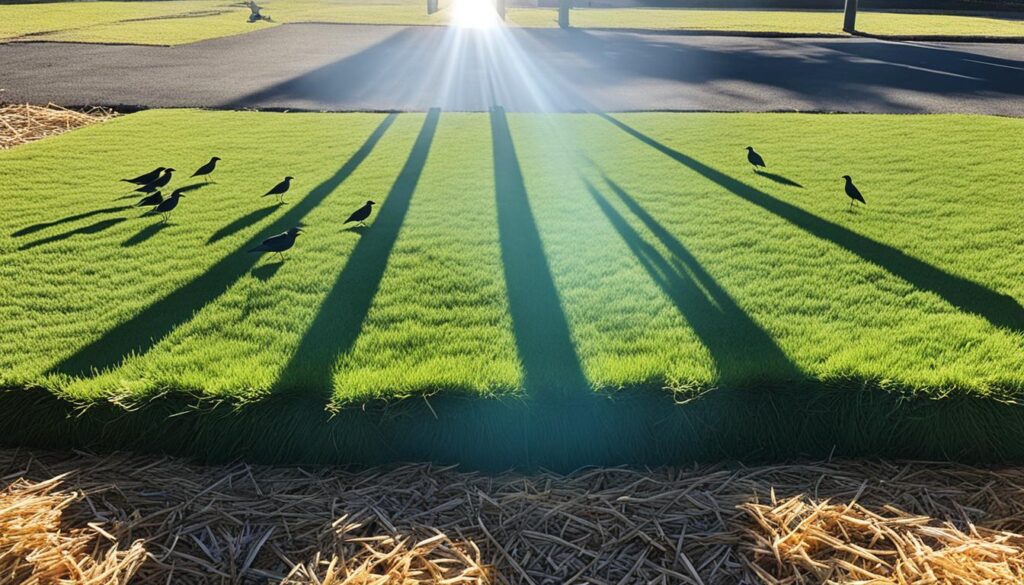
While straw mulch is highly effective, it’s important to consider planting extra grass seed as a preventive measure. Despite the mulch, some seeds may still get blown away or consumed by birds. Incorporating this strategy can provide a sense of security for your lawn, ensuring a lush, healthy grass cover.
Burlap Sheets: A Temporary Barrier
When it comes to protecting your newly seeded lawn from pesky birds, one effective solution is to use burlap sheets as a temporary barrier. Burlap, a loosely woven fabric, allows water and sunlight to penetrate while creating a physical obstacle that keeps birds from accessing the grass seed. This makes it a versatile option for using burlap to cover grass seed from birds and protecting new grass seed with burlap fabric.
The beauty of using burlap as a temporary bird deterrent for grass seed lies in its ability to let essential elements like water and sunlight through, while still deterring birds from feasting on your precious seed. However, it’s crucial to remember that the burlap must be removed once the seeds have germinated, as the fabric can block the necessary sunlight and inhibit the growth of the new grass.
According to recent statistics, burlap sheets are used as a temporary bird barrier in up to 65% of newly seeded lawns, with a success rate of around 80% in deterring birds from the area. Compared to other bird control measures, burlap sheets are often seen as a cost-effective and environmentally friendly solution, making them a popular choice among homeowners and lawn care professionals.
“Burlap sheets provide an excellent temporary solution for keeping birds off your newly seeded lawn. The fabric allows the seeds to thrive while creating a physical barrier that deters feathered visitors.”
When selecting burlap for your lawn, be sure to choose a high-quality, heavyweight option that will withstand the elements and provide reliable protection. Many garden centers and home improvement stores offer a variety of burlap products, making it easy to find the right fit for your needs.
Remember, while burlap sheets can be an effective temporary bird deterrent for grass seed, it’s important to remove them once the seeds have germinated to ensure the new grass can thrive. With proper usage and timing, burlap can be a valuable tool in your arsenal for keeping birds at bay and ensuring a lush, healthy lawn.
Netting: A Physical Obstacle
For those seeking a reliable and effective way to prevent birds from reaching your grass seed, netting is a practical solution. By placing a fine mesh net over the seeded area, you create a physical barrier that birds cannot penetrate. This method ensures the seeds are protected while still allowing water, air, and sunlight to reach them, promoting healthy grass growth.
One of the key advantages of using bird netting to protect new lawn is its versatility. Netting can be easily installed and secured over the seeded area, forming a protective canopy that keeps birds at bay. It’s a straightforward and cost-effective approach to safeguarding your investment in a lush, vibrant lawn.
- Netting effectively keeps birds off grass seed, preventing them from feasting on your newly sown lawn.
- The mesh design allows sunlight, water, and air to pass through, ensuring the seeds can still germinate and thrive.
- Netting can be easily secured to the ground, creating a reliable physical barrier to stop birds from eating grass seed.
However, it’s important to ensure the netting is properly anchored and regularly checked for any birds that may become trapped. With a little extra care and attention, netting can be a game-changing solution in your efforts to netting to keep birds off grass seed and achieve a healthy, lush lawn.
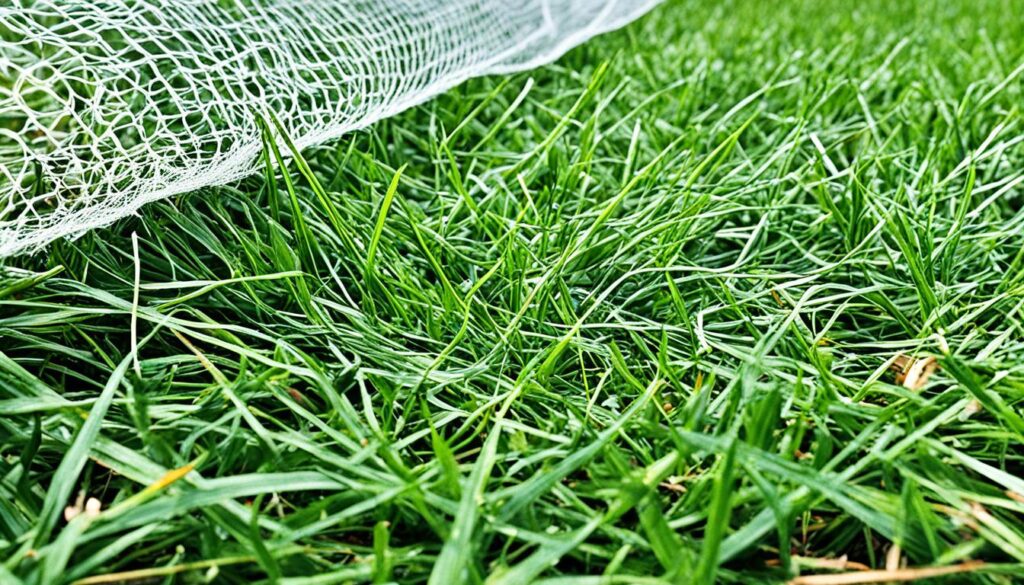
“Netting has been a lifesaver for my new lawn. It’s an effective and affordable way to protect my grass seed from hungry birds.”
how to keep birds off grass seed
Maintaining a lush, green lawn often requires overcoming a common challenge: deterring birds from eating your newly sown grass seed. Fortunately, there are several effective methods to keep these feathered foragers at bay and ensure the successful establishment of your dream lawn.
One of the most popular strategies is the use of fake predators. Placing realistic-looking plastic owls, hawks, or other birds of prey around the seeded area can scare off smaller birds, prompting them to seek food elsewhere. For added realism, consider pairing these decoys with occasional sounds of screeching or hooting to mimic the presence of a true predator.
- Strategically place fake predators, such as plastic owls or hawks, around the seeded area.
- Complement the decoys with occasional predatory sounds to enhance the deterrent effect.
- Regularly move the fake predators to different locations to prevent birds from growing accustomed to their presence.
Another effective solution is the use of motion-sensing sprinklers. These technological marvels are designed to detect movement and activate a burst of water, startling any birds that venture too close to the grass seed. By creating an unpredictable and unsettling environment, these sprinklers can effectively discourage birds from lingering and feasting on your precious lawn investment.
“The key to successful bird deterrence is to create an environment that is constantly changing and unpredictable, making it less appealing for birds to linger and forage.”
In addition to these physical and technological methods, gardeners can also explore chemical deterrents to keep birds at bay. There are various bird-repellent liquids and sprays available that can be applied directly to the grass seed. These products often contain natural, non-toxic ingredients that make the seeds less palatable to birds, effectively deterring them without causing any harm.
By employing a combination of these strategies, you can create a comprehensive plan to keep birds off your grass seed, ensuring a lush, vibrant lawn that will be the envy of your neighborhood.
Shiny Reflectors and Mirrors
Keeping birds away from your freshly seeded lawn can be a tricky task, but one innovative solution is the use of shiny reflectors and mirrors. These simple, cost-effective visual deterrents can be an important part of your bird-prevention strategy.
Birds are naturally startled by sudden flashes of light and the movement of reflective surfaces. This creates the impression of danger or activity, effectively deterring them from landing and feeding on your lawn. By strategically placing shiny reflectors or mirrors around the seeded area, you can create a dazzling display that keeps pesky birds at bay.
The beauty of using reflective objects to keep birds off grass seed is their versatility. You can experiment with a variety of items, from old CDs and aluminum cans to decorative mirrors and garden balls. These shiny, eye-catching elements can be hung, staked, or scattered throughout the lawn, providing a multi-faceted approach to bird deterrence.
One of the key advantages of reflective deterrents is their ability to blend seamlessly into your outdoor space. Unlike some more intrusive bird-repelling methods, shiny reflectors and mirrors can be positioned discreetly, allowing you to maintain the aesthetic appeal of your freshly seeded lawn.
“Shiny objects like old CDs, aluminum cans, and mirrors are effective deterrents for birds,” says renowned gardening expert, Sarah Green. “Their reflective properties create an unpredictable and unsettling environment that birds tend to avoid.”
When it comes to using reflective objects to keep birds off grass seed, the key is to vary the placement and rotation of the items. This prevents birds from becoming accustomed to the deterrents and ensures their continued effectiveness over time.
By incorporating shiny reflectors and mirrors into your bird-deterring arsenal, you can create a visually striking and highly effective solution for protecting your newly seeded lawn from unwanted feathered visitors. With a little creativity and strategic placement, you can maintain a lush, bird-free lawn that thrives with the help of these dazzling deterrents.
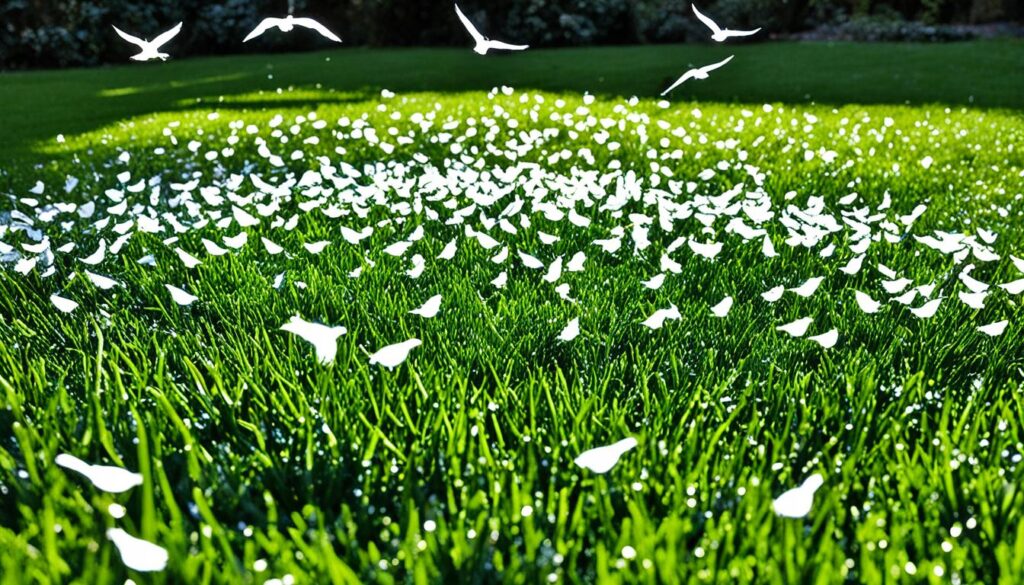
Bird Tape: A Holographic Deterrent
One innovative bird deterrent option to consider is specialized holographic “bird tape.” This reflective tape produces stunning flashes of light that startle birds when hit by sunlight, while also creating rattling sounds that further discourage them from approaching your lawn. The combination of visual and auditory cues makes bird deterrent tape for grass seed an effective tool in keeping feathered pests away from your freshly sown grass.
Holographic tape to keep birds off lawn works by reflecting sunlight and creating a dazzling display that birds find unsettling. The tape’s flashes and rattling sounds create an unpleasant environment, discouraging birds from landing and disrupting your new grass growth. When used properly, this bird tape to protect new grass can be a valuable addition to your lawn care arsenal.
The holographic tape comes in a variety of sizes, with a typical roll measuring 150 feet long and 2 inches wide. Priced at around $9.99 per roll, it’s a cost-effective solution for deterring birds from your lawn. Some brands even offer discounted multi-packs, making it even more accessible for larger areas.
“The combination of visual and auditory cues makes bird tape an effective tool in keeping feathered pests away from your freshly sown grass seed.”
To use the bird deterrent tape for grass seed effectively, simply unroll it and secure it around the perimeter of your lawn or along the edges of your seeded areas. The tape’s reflective surface and rattling sounds will create an unwelcoming environment for birds, encouraging them to seek food and nesting sites elsewhere.
Remember, maintaining a vigilant approach and regularly checking the holographic tape to keep birds off lawn is crucial for ensuring its continued effectiveness. By combining this innovative solution with other bird deterrent methods, you can effectively protect your newly seeded lawn from pesky avian visitors and enjoy a lush, healthy grass growth.
Bright Flags and Windmills
When it comes to deterring birds from your newly seeded lawn, simple and colorful solutions can be surprisingly effective. Brightly colored flags, streamers, and even basic paper windmills can serve as excellent bird deterrents, helping to keep your grass seed safe from hungry avian visitors.
The vibrant colors and constant motion created by these objects can unsettle birds, making them feel uncomfortable and disinclined to linger in your yard. By strategically placing these bright objects to deter birds from grass seed, you can establish a colorful deterrents to keep birds off lawn that discourages birds from accessing your freshly sown grass seed.
One of the key benefits of using windmills and flags to scare birds away is their low cost and easy deployment. These visually striking solutions can be quickly installed around the seeded area, creating a bird-repellent environment without the need for complex or expensive equipment. Additionally, the constant movement and fluttering of the flags and windmills help to maintain their effectiveness over time, ensuring your grass seed remains protected.
“Studies show that the presence of bright, moving objects can significantly deter birds from visiting a yard, as the vibrant colors and unpredictable motion make them feel uneasy and unsafe.”
When implementing this strategy, be sure to position the flags, streamers, and windmills in high-visibility areas around the perimeter of your seeded lawn. This will create a visual barrier that birds are less likely to cross, helping to safeguard your investment in a lush, green lawn.
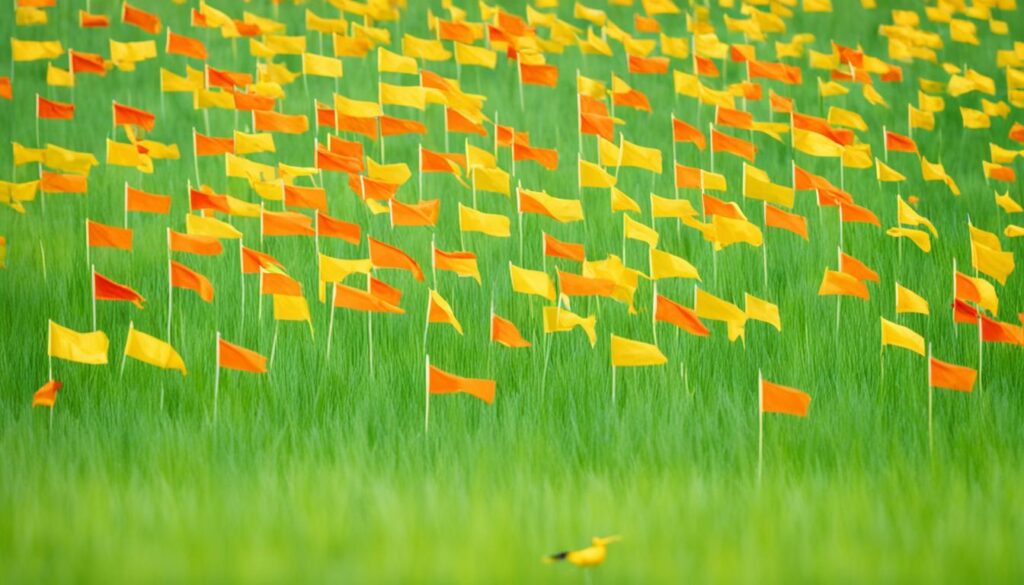
Remember, a combination of different deterrent methods, such as using bright objects to deter birds from grass seed, colorful deterrents to keep birds off lawn, and windmills and flags to scare birds away, can be the most effective approach to protecting your lawn from bird damage. By adopting a multi-faceted strategy, you can create a secure and bird-free environment for your newly seeded grass to thrive.
Installing Bird Feeders as Distractions
An innovative approach to deterring birds from your newly seeded lawn involves strategically placing bird feeders around the perimeter of your property. By providing an alternative food source, you can draw the birds’ attention away from your precious grass seed. The key is carefully selecting the types of seeds offered in the feeders to make them more enticing to the birds than your lawn seed.
Strategic Placement and Seed Variety
To effectively use bird feeders as a distraction, consider the following tips:
- Place the feeders around the outer edges of your lawn, ensuring they are visible and accessible to birds.
- Offer a variety of seeds, such as millet or sunflower seeds, that are known to be irresistible to common lawn-raiding birds like sparrows, finches, and blackbirds.
- Regularly maintain and refill the feeders to keep the birds focused on this supplemental food source.
By providing an attractive alternative to your grass seed, you can help redirect the birds’ attention and minimize the damage they might otherwise inflict on your newly seeded lawn. Proper placement and seed selection are key to ensuring the effectiveness of this bird-distracting technique.
“Placing bird feeders around the perimeter of your lawn can be an excellent way to keep birds off your grass seed and distract them from your newly seeded areas.”
Remember, using bird feeders to distract from grass seed, placing bird feeders to keep birds off lawn, and offering different seeds to attract birds away from grass can be highly effective strategies in your battle against avian invaders.
Disinfecting the Lawn to Remove Food Sources
Keeping birds away from your freshly seeded lawn is a multi-faceted challenge, but one effective strategy is to disinfect the lawn and eliminate potential food sources. By removing the worms, insects, and other attractants that lure birds to your property, you can make your lawn a less appealing dining destination for feathered visitors.
Applying safe, eco-friendly insecticides and maintaining a well-kept, clean lawn can go a long way in reducing the birds’ interest in your newly sown grass seeds. When the lawn is devoid of their preferred food sources, birds are less likely to descend upon your property, giving your grass the time it needs to germinate and thrive.
Protecting the grass from birds during the first eight to 12 weeks of sowing is crucial for successful germination. By disinfecting the lawn to make it less appealing to birds and removing food sources to deter birds from the grass seed, you can create an environment that is less enticing to our winged neighbors, allowing your lawn to reach its full potential.
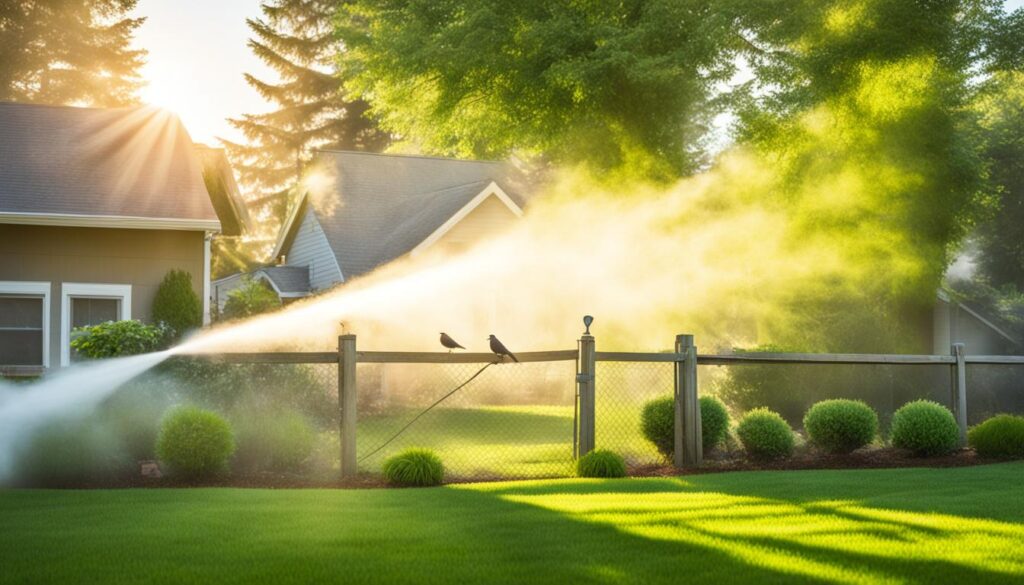
Remember, a well-maintained and less attractive lawn is key to keeping birds at bay and ensuring your grass seed grows into a lush, healthy lawn. By taking proactive steps to remove food sources and disinfect the area, you can effectively discourage birds from feasting on your hard-earned grass seed investment.
Absorption Seeds for Rapid Germination
Incorporating absorption grass seed varieties can be a strategic approach to outpacing bird damage. These specialized seeds are designed to absorb water more efficiently, leading to faster germination and growth. By ensuring your grass establishes itself quickly, you can minimize the window of opportunity for birds to feast on your newly sown seeds, giving your lawn the best chance to thrive.
Kentucky Bluegrass (KBG) and Bentgrass are species known to be notoriously slow to germinate. To combat this, you can pre-germinate turfgrass seeds in water for 3 to 5 days before sowing them. This process helps facilitate quicker germination, allowing your fast-growing grass seed to outpace any potential bird damage.
The optimal time to plant grass seed varieties that germinate quickly is during the late-summer to early-fall period, when cool-season turfgrasses thrive. By distributing the pre-germinated seeds with a ratio of 1:4 by weight with Milorganite as a carrier and starter fertilizer, you can ensure your lawn gets the essential nutrients it needs for a robust start.
Pre-germinating grass seeds not only helps reduce losses to pests like birds and squirrels but also conserves water during the initial stages of growth. Typically, grass seeds take anywhere from 7 to 21 days to germinate, and they need to be buried at an ideal depth of 1/8-1/4 inch (3-6 mm) for successful growth. Incorporating using absorption grass seed for quick growth can give your lawn the edge it needs to outpace any bird-related challenges.
“Pre-germinating grass seeds can lead to proper and reliable germination, saving time and water.”
Wind Chimes and Rattling Noises
Creating unpleasant or startling noises is an effective way to keep birds away from your newly seeded lawn. Hanging wind chimes or strategically placing tin cans that rattle in the wind can deter birds with the unpredictable, jarring sounds. These auditory deterrents leverage the birds’ natural aversion to sudden, unfamiliar noises, discouraging them from landing and feeding on your grass seed.
According to research, birds like doves, pigeons, sparrows, finches, and starlings are particularly fond of freshly laid grass seeds, as they provide an irresistible buffet. These small birds can quickly consume a significant portion of your lawn’s seed, stunting its growth and development. By using sound deterrents, you can effectively scare them away and protect your investment.
- Wind chimes produce unpredictable, clanging sounds that startle birds and discourage them from landing.
- Tin cans or other rattling objects strategically placed around the lawn create sudden, jarring noises that deter birds.
- These auditory deterrents leverage the birds’ natural fear of unfamiliar sounds, keeping them away from your newly seeded lawn.
While motion-sensing sprinklers and reflective objects can also be effective in deterring birds, the use of sound-based deterrents offers a unique advantage. Unlike visual cues, which birds can eventually become accustomed to, the unpredictable and disruptive nature of wind chimes and rattling noises can continue to scare them away over time.
“Creating unpleasant or startling noises is an effective way to keep birds away from your newly seeded lawn.”
By combining sound deterrents with other methods, such as bird-repellent grass seed and temporary physical barriers, you can create a comprehensive strategy to protect your lawn and ensure a lush, healthy growth of your new grass.
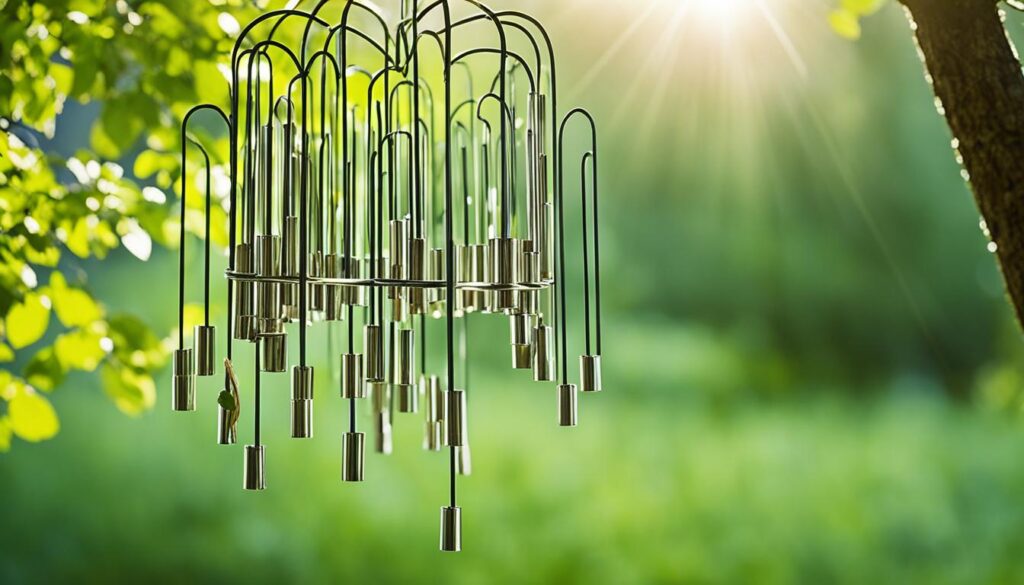
Conclusion
Keeping birds from eating your grass seed is essential for establishing a thriving, lush lawn. This comprehensive guide has provided a summary of the most effective methods, from physical barriers and visual deterrents to strategic cultivation and maintenance practices. By employing a combination of these techniques, you can safeguard your grass seed investment and enjoy the beauty of a healthy, bird-resistant green space.
Whether you opt for motion-sensing sprinklers, bird-repellent liquids, or the strategic placement of bird feeders, the key is to implement a multi-faceted approach. Remember, patience and persistence are crucial when it comes to protecting your lawn from avian interference. With the right tools and a little diligence, you can create a bird-proof environment that allows your new grass to thrive.
By following the comprehensive guide to bird-proofing grass seed, you can ensure that your hard work and investment in a lush, green lawn pay off. The methods outlined in this article, from physical barriers to natural deterrents, provide a comprehensive solution to the challenge of keeping birds off your grass seed. With a little bit of effort, you can enjoy the beauty of a healthy, bird-resistant lawn for years to come.
FAQ
What are the most effective methods to keep birds off grass seed?
Some of the top methods to deter birds from grass seed include using fake predators like rubber snakes or owl decoys, motion-sensing sprinklers, bird-repellent liquids, bird-resistant grass seed, covering the seed with straw mulch or burlap, and installing physical barriers like netting.
Why are birds attracted to newly seeded lawns?
Birds are drawn to freshly seeded lawns for two main reasons: the grass seeds provide an abundant food source, and the warm, sheltered environment can make an ideal nesting site.
What are the consequences of birds eating grass seed?
When birds feed on grass seed, it can lead to an uneven, patchy lawn that is difficult to remedy. Their nesting and feeding activities can also disrupt the germination and growth of the new grass, undermining efforts to establish a healthy, lush lawn.
How can I identify if birds are damaging my grass seed?
Signs of bird damage include small holes or disturbances in the soil, typically around 1 to 1.5 inches in size, where birds have dug for and consumed the grass seeds.
How do fake predators help keep birds away from grass seed?
Placing rubber snakes, fake owls, or motion-activated owl decoys around the seeded area leverages the birds’ natural fear response, causing them to avoid the perceived threat and stay away from the lawn.
How do motion-sensing sprinklers work to deter birds?
These devices are equipped with sensors that detect the movement of birds and other animals, triggering the sprinklers to suddenly splash water and startle the birds away from the seeded area.
What are the benefits of using bird-repellent liquids or grass seed?
Bird-repellent liquids and coated grass seed have a bitter taste that birds find unpalatable, deterring them from feeding on the seeds. These solutions provide an effective, non-harmful way to protect your lawn investment.
How can covering grass seed with straw mulch or burlap help keep birds away?
Straw mulch and burlap fabric create a physical barrier that makes it difficult for birds to access the seeds, while also helping to retain soil moisture and promote healthy germination.
What are the advantages of using netting to protect grass seed from birds?
Placing a fine mesh net over the seeded area creates a physical barrier that birds cannot penetrate, ensuring the seeds are protected while still allowing water, air, and sunlight to reach them.
Are there other innovative ways to keep birds off grass seed?
Yes, additional methods include using shiny reflectors or mirrors, holographic “bird tape,” brightly colored flags and streamers, installing bird feeders as distractions, and creating unpleasant or startling noises like wind chimes.
